Donat Krasniqi’s passion springs from “heaven, not earthly musings”, and he believes his art will survive and dominate the modern era with the goal of becoming a classic master of Baroque.
Facing a painting adorned with vibrant Baroque colours, the melody of an epic composition is enough to detach oneself from reality and enter a divine cycle surrounded by existential questions.
Donat Krasniqi, a Baroque artist from Prishtina, finds himself at the same age as the renowned sculptor, Renaissance master Michelangelo when the latter created the magnificent Vatican marble sculpture “La Pietà” depicting Jesus and Mary.
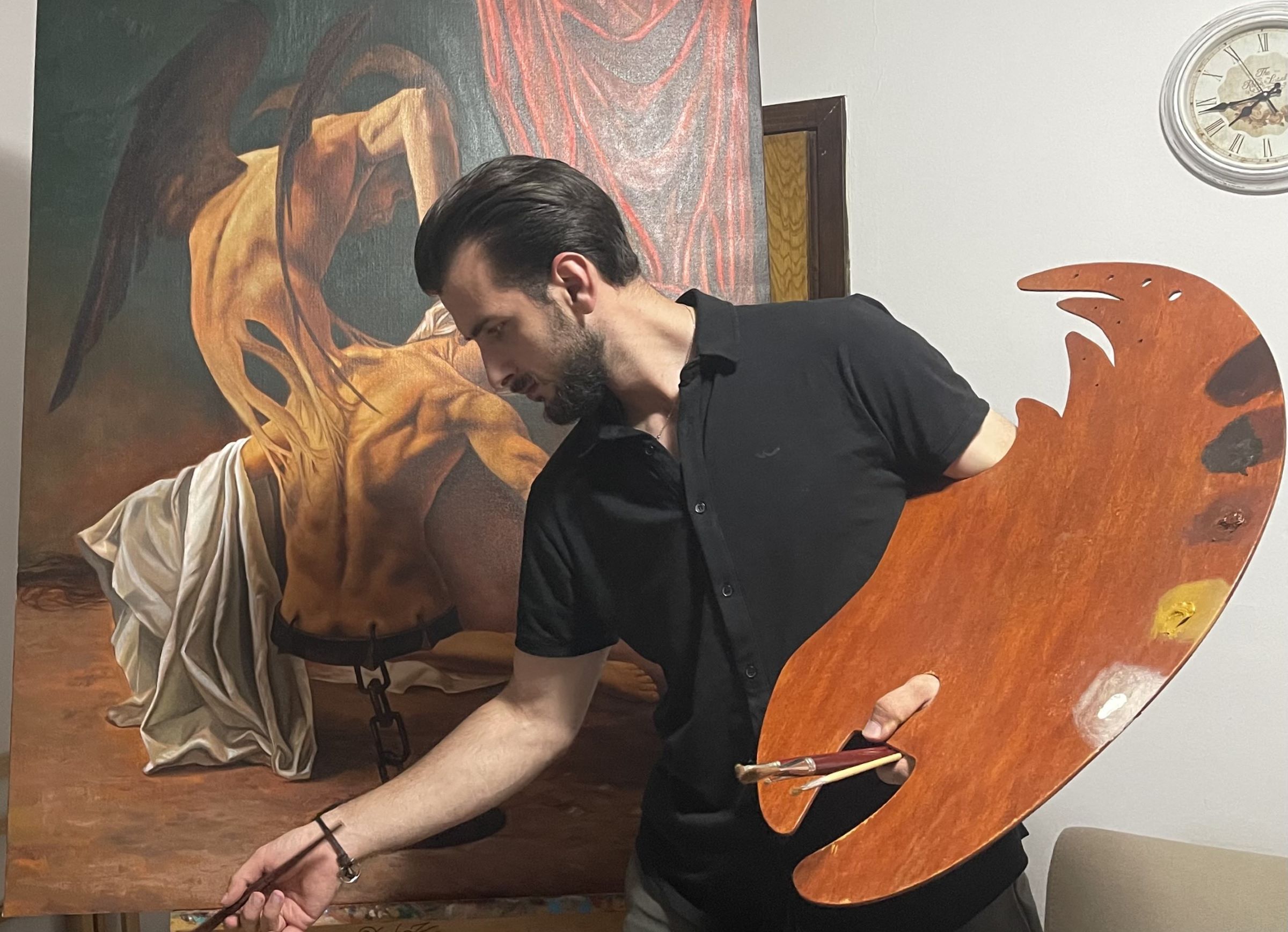
Donat Krasniqi, a Baroque artist from Prishtina. Courtesy of Donat Krasniqi.
At the age of 25, Donat shares the same ambition as his Baroque paintings, which exude a timeless quality – he aspires to be a “classic master of art” and leave a lasting legacy with his creative endeavours.
Michelangelo is Donat’s role model. He considers the Italian master’s artistic creation as “transcendental perfection”.
Donat’s paintings speak and remain silent, cry and scream, divide and conceal pain, taking you on a journey thousands of years back in time while still looking from the present. Time is hidden in each of his paintings, as if it were the common denominator of the painting, the artist, and the period to which he would like to belong – the 17th century.
“Although abstract art prevails in this era, which I understand, I know that I am not on trend… and I do not want to praise or disparage myself. On one hand, it’s good to be unique, but on the other hand you can’t sell it, or the ones who buy it are rare people,” Donat said in an interview with Prishtina Insight.
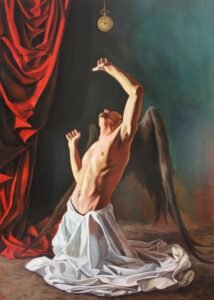
One of Donat’s favourite paintings is the one he named ‘Time Attack’, depicting a naked man with raised hands seeking mercy. Courtesy of Donat Krasniqi.
Throughout the centuries, Baroque artists with their vivid colours have highlighted a painful reality between the surreal and the real.
Baroque can take a person from one corner of the world to the other, and they make it seem as if you can see the universal reality within a frame.
Apart from studying the artistic theme of time at university, the theme also dominates each of Donat’s paintings, whether through an hour hand that looks like an arrow, a golden hourglass, an old clock descending from above, two merciful hands pointed towards the sky, or a spiral storm in a circular form.
“We humans are victims of time, whether we accept it or not. We are born, grow up and die, but time never stops, and, naturally, this connection from the Baroque to modern times happens. Donat Krasniqi, a Baroque artist
Can the ‘hand’ of the 17th century survive in the 21st century?
The extent of change that humanity has undergone from the Baroque era to modern times is evident in each figure portrayed in Donat’s s paintings: powerful hands, accentuated body lines, and deep-set eyes reflect modern people beneath the cloak of classical humans.
However, can a Baroque artist survive in an era where artificial intelligence can paint whatever anyone desires with a touch of a button?
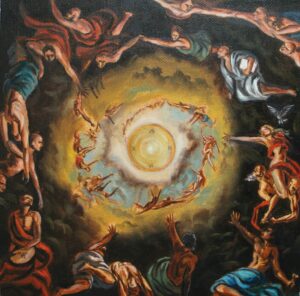
Similar to the painting of artist Gustave Dore, but with Donat’s colours, the storm of time is pleasantly presented in a whirlpool form. Courtesy of Donat Krasniqi.
Similar to the painting of artist Gustave Dore, but with Donat’s colours, the storm of time is pleasantly presented in a whirlpool form. People travel, reach out to each other, find, and lose themselves in a cycle leading to a black hole that engulfs the entire surface, but in the end, it’s just a focal point: time, presented divinely with Roman numerals in each quarter.
Paradoxically, Donat considers artificial intelligence to be helpful to artists since, instead of arranging 12 people to paint Leonardo da Vinci’s “The Last Supper,” he can arrange them through a regenerated photograph.
However, the young artist does not believe that the commonality of changing eras will defeat his art, even if it is considered out of fashion.
“Fashion always returns, just like your classic shirt with modern features,” Donat explained while analysing art in a journalist’s shirt.
Amidst white, red, and green, and everything in between, one of his favourite paintings is the one he named ‘Time Attack’, depicting a naked man with raised hands seeking mercy.
To create this painting, Donat spent hours sitting in his painting corner at home, inspired by his father’s state of mind when he retired, feeling dissatisfied that he grew old and could not contribute more.
“[…]It’s more of a quest for mercy from time because time is divine. We do not see it, we only see how it affects our body. I present it as a clock, as a form of mercy for lost time,” Donat explained of ‘Time Attack’.
Donat does not sell his paintings through auctions as was common in the past, but through social media. While his most cherished paintings, on which he works for months, are hard to sell to anyone.
Baroque artworks are not common in today’s Kosovar society. However, children grow up with figures of Venus and Mars in figurative art books.
“[…]When the painting doesn’t call me, I don’t go to paint because it’s better when it calls you, when the painting tells you to paint. But when I don’t feel that inner voice, I won’t paint, as it would only waste my time,” Donat explained.
Finding oneself through rarity
Painting has no shame, just as the human body and its creation are not shameful. From the tip of the eye to the reprodutive organs, every part of the human body expresses something irreplaceable, best represented through a painting that conveys an idea.
“Only with a human body you can convey a great message, even with just one movement. It is communication without words,” Donat described.
In Albanian society, depicting naked figures like “Venus and Cupid” and “Lucretia” paintings is still somewhat seen as a taboo, to the extent that one of the prejudices that Donat encounters is why he paints naked female bodies.
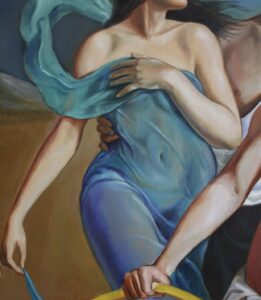
In each semi-naked painting by Donat, a vibrant-coloured drapery is seen covering the reproductive organs of the human, resembling the old Christian paintings. Courtesy of Donat Krasniqi.
Naked figures have always been an inspiration for great artists, especially those of the Baroque era, both because of the power they carry and their aesthetics.
In each semi-naked painting by Donat, a vibrant-coloured drapery is seen covering the reproductive organs of the human, resembling the old Christian paintings.
Krasniqi believes that the female figure has always been the foundation of society as the future of humanity.
“When I used to draw semi-naked [people] in school, I saw it more as a body rather than what artists managed to produce, [and] unlike how my classmates perceived it as shameful,” Donat explained, adding that he discovered his talent in elementary school, strengthening it in an art course for a year, and then continuing his painting studies at the University of Prishtina.
The artist has always painted only in the Baroque style and, in this less common form, he tries to convey self-aware messages to society, unlike abstract forms.
“My passion comes from heaven, not earthly musings,” is one of his favourite sayings by the artist Peter Paul Rubens, which he considers as motivation for his work.
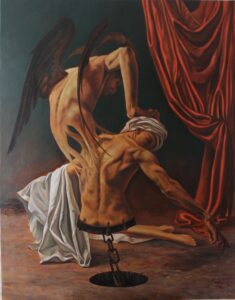
The murder of Marigona Osmani by her boyfriend Dardan Krivaqa is “embroidered” in the form of resentment on a white cloth. Courtesy of Donat Krasniqi.
One of his paintings immersed in blood painfully displays reality. The murder of Marigona Osmani by her boyfriend Dardan Krivaqa is “embroidered” in the form of resentment on a white cloth.
In the forefront, a central figure or the protagonist is seen, and all his resentment appears transformed like a demon escaping from his soul through his back, like black wings with ribs; the white part is placed on the lower part of the body as a disguise from society, as a cover for his true face. Meanwhile, in the background, the victim’s legs are visible, and the killer feeds the unbridled imagination of the demon with the blood of the victims.
“All this resentment comes from a worse source, from the earth. I divide this part: the earth is hell, paradise is the sky,” he explained, adding that he created this painting as a form of protest against society.
Caravaggio, Rubens and Michelangelo remain the only artists to inspire him.
Donat Krasniqi sees Baroque as an inseparable part of his being, to the extent that he sacrifices the pleasures of his youth to return to his artistic corner to work until late at night.
“When I paint, I only say one thing to myself “just look at those paintings and how many years they have been there,” and that ignites a kind of fire within me. I only stop if a hand is severed or a tragic accident happens; otherwise, I won’t give up Baroque,” the artist concluded.





